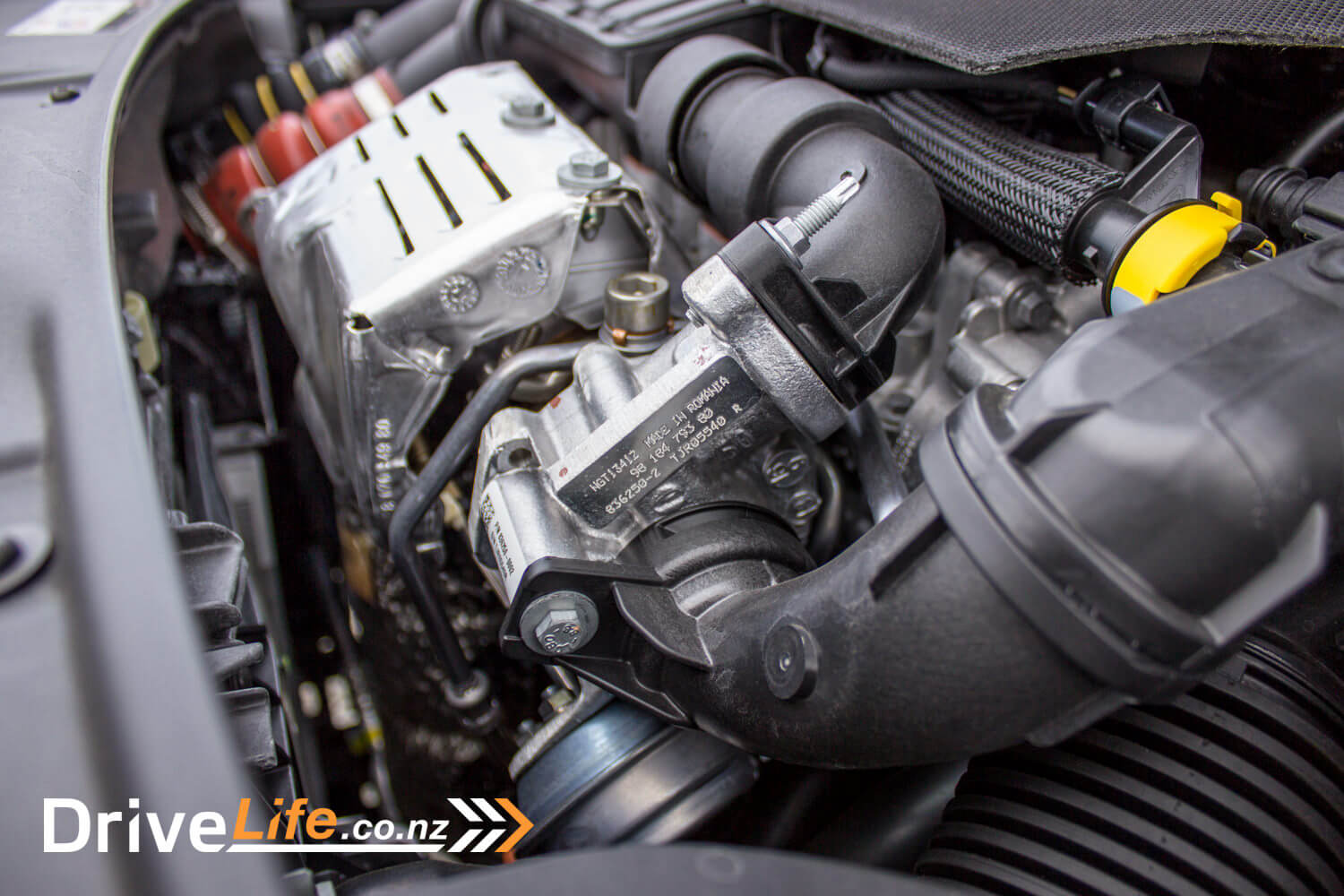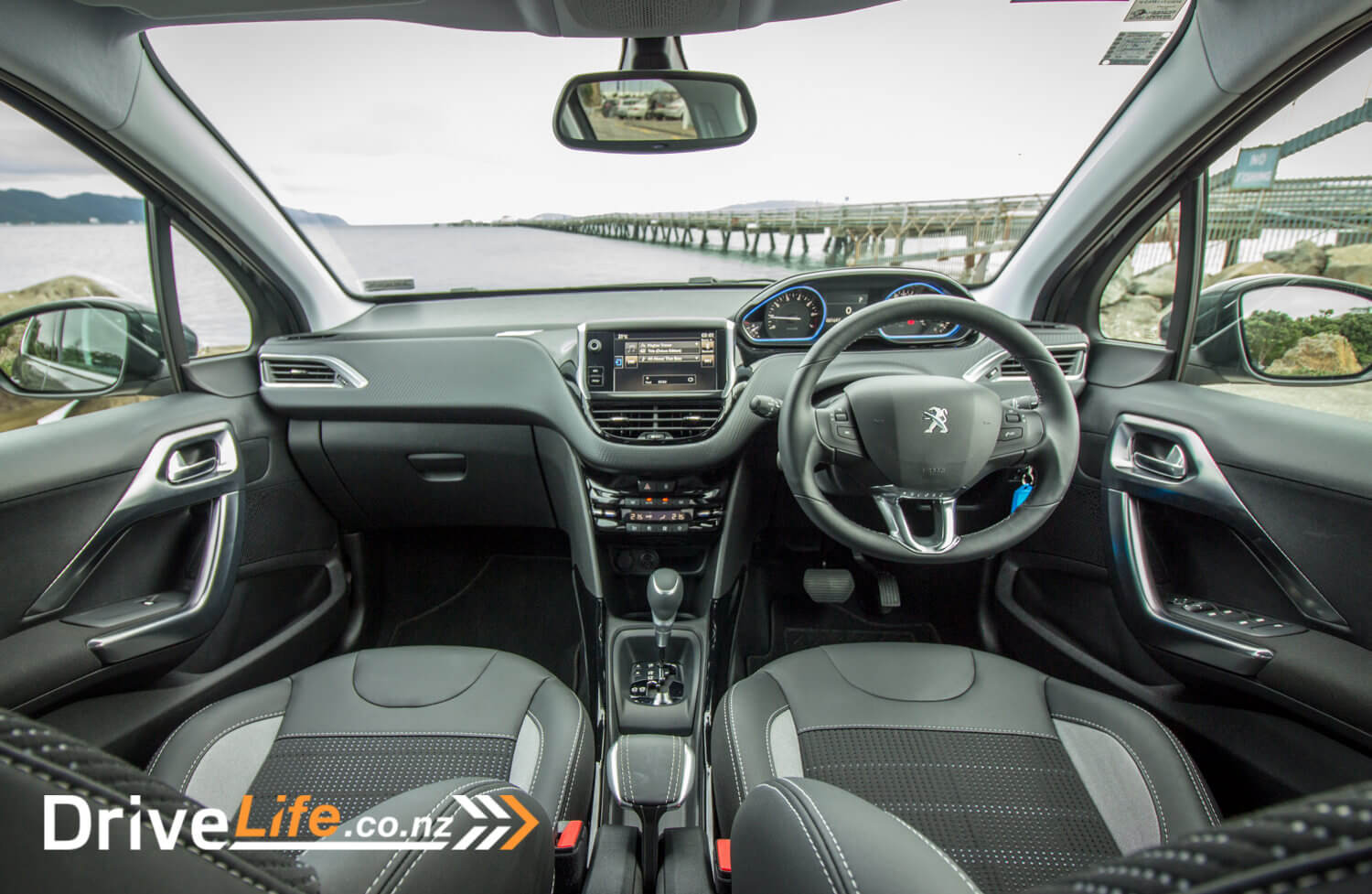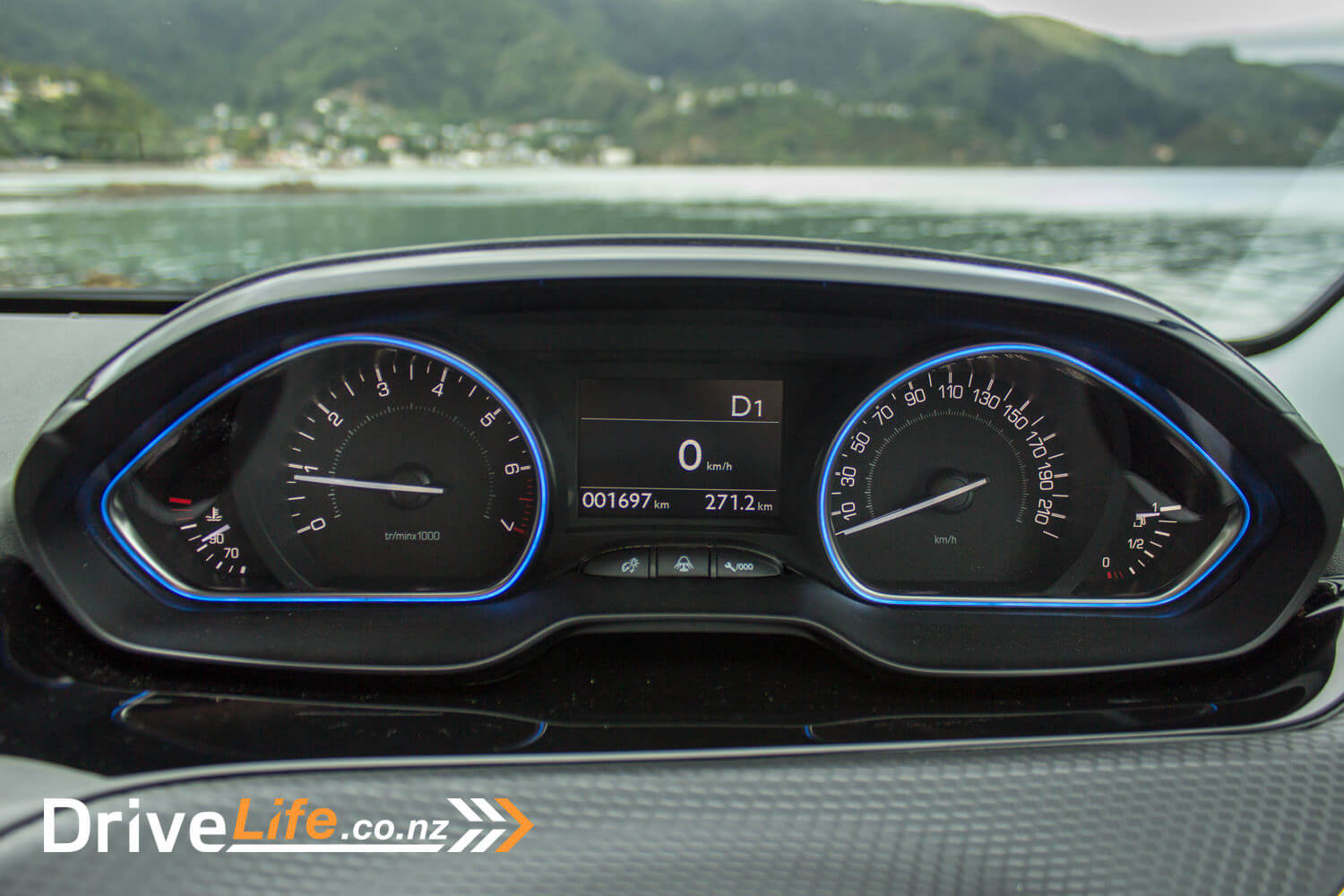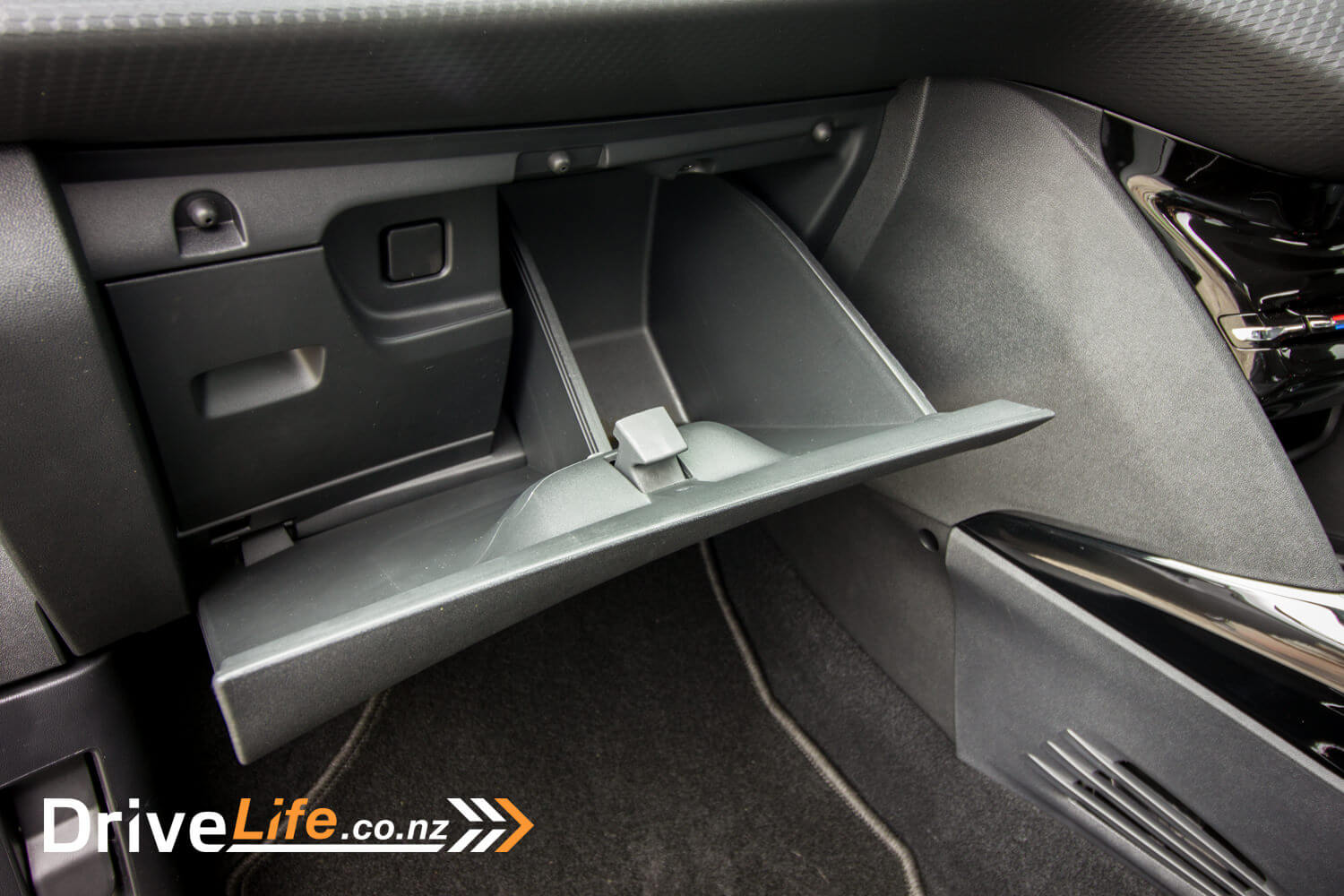This year, Peugeot New Zealand released an updated 2008 SUV, complete with a 1.2-litre, 3-cylinder turbo petrol engine.
Readers of Drive Life may remember I’ve been looking for this size SUV to replace our ageing Honda Odyssey. The Suzuki Vitara Turbo didn’t quite do it (but was close); the Hyundai i20 Cross was a fair way off the mark with that 74Kw engine and 4-speed automatic. The Kia Soul was a contender, but was underpowered with its 2-litre engine.
Could the facelifted 2008 be the answer? The specs said yes. What would a week-long test say?
Don’t expect the French to have a car that looks like any other. The 2008 stands out from the crowd, even when it’s dark grey like our test car. Front, side or rear, there are enough design touches to make it look just that bit different, but in a good way. I don’t think the photos do it justice here – looking at them, in particular the front doesn’t look as good as it does in the flesh.
Add to this the bits of chrome work around the entire body (including on the roof spoiler) and she’s a good looking car. I wish Peugeot had sent me one in an actual colour, but the chances were never good: the 2008 is available in 9 colours, and 4 of those are shades of grey. Add two shades of white and there’s not many real colour choices.
The Range
There’s two models available; the Allure (tested) at $34,990 and the GT Line priced at $36,990.
The Allure is pretty well kitted out for $34,990. Standard equipment is SatNav with a 7” touchscreen central monitor, height adjustable driver’s seat, reversing camera and sensors, auto headlights and wipers, auto-dipping rear-view camera, cruise control with speed limiter, 6-speaker stereo with Bluetooth, USB, Apple Carplay and Android Auto capability. LED DRLs are also standard, along with front and rear fog lights – and the fronts have a cornering function. Heated exterior mirrors, Nappa leather steering wheel, and a trip computer round off what you get with the car.
GT Line adds mostly cosmetic changes – such as different interior trim, but does come with Active City Brake safety system. It also comes standard with Grip Control – a dial which allows you to select different types of surfaces to drive on – but it’s still FWD only. It also has alloy pedals, chrome door sills, black mirrors, and other normally chromed body parts are now black.
While the Allure has 16” alloys, the GT Line has 17”, with a $500 option of painted black wheels instead of shiny ones.
The Interior
Your first impression on opening the door may well be the pillars and headlining. I’m glad they aren’t black, but they are bordering on arctic white. It’s not bad, but it sure ain’t beige. It does help to lighten up the interior, and that’s always a good thing. There’s some lashings of piano-black trim, and more chrome-plastic touches to break up the plastic.
Second impression? That is tiny steering wheel – Peugeot calls it ‘compact’. It feels like you are in a sports car. But what then strikes you is Peugeot’s ‘Head up instrument panel’ – which isn’t a Head Up Display, but simply means they’ve moved the whole instrument binnacle up high, so you actually look at it over the steering wheel, not through it. This feels weird.
To start with, I adjusted the steering wheel as high as I could, but this blocked most of the instruments. I’m going to be honest here – I hated it. But on the second day, I dropped the steering wheel as low as it would go and voila! There were the instruments, clear as day. Sure, the wheel felt lower than it should be, but I quickly got used to it, and now love it. It’s a short glance down while you are driving for that never-ending check of your speed.
According to Peugeot, “The compact sports steering wheel sits lower than a traditional design and means that your arms are both lower and closer together. This not only reduces driver fatigue but offers more precise steering and improved manoeuvrability.”
Added to this is the digital speedo, in addition to the normal analogue one. It’s right in the middle of the dash, and crystal clear – perfect.
Also in this area of the dash, above the digital speedo, is a gear indicator that shows you the actual gear the transmission is in. I love this – yes it’s an automatic but it’s peace of mind when you know what the trans is doing.
You can switch the digital display to other items, like the SatNav turn-by-turn, fuel economy and the like. These are switched in true European fashion – by pressing the button at the end of the wiper stalk. Simple and it works.
Still on the instrument binnacle, the Allure model means there is a nice blue illuminated rim around the speedo and rev counter, while the GT Line is red, for more speed or something. You can switch them off but they aren’t distracting and look pretty cool, according to my passengers.
There’s a fair amount of black plastic inside, but as mentioned there are nice textures used around the cabin. Again, it looks pretty classy.
Down on the centre console, there’s an ‘aviation style’ handbrake. It’s a big chunky handbrake, but does the job.
I had an issue with the centre console cubby, the one behind the handbrake. This is the first car I can remember, where the cubby is not also an armrest. Unfortunately, I forgot one day and rested my elbow on it in an effort to move my ass around on the seat – and broke the cover.
Well, pushed it inside the cubby more like. Some gentle persuasion got it all back together again.
Still on the centre console, there are some cup holders, but they are tiny. I couldn’t get a McDonald’s coffee cup to fit in there, which is my measure of success. Speaking of tiny, the glove box is one of those ones for gloves, and not too much else. My test car didn’t come with a manual, but there’s no way it would have fitted in there.
Since it’s a French car, you’ve got to expect a few more ‘interesting’ things, like the fact that you can’t sync the dual-zone AC. It’s great to have dual-zone for those times when you need it, but for me most times I just leave it synched. Can’t do that on the 2008.
Another slight annoyance is that the auto wipers go off with the car. You push down on the stalk to turn on automatic mode, but when the ignition goes off, so does auto mode. On the plus side, there is a dash light to show the wipers are on automatic, which isn’t something I’ve seen before but pretty handy.
The infotainment system is dead simple to use, and the SatNav too is dead easy. Stereo quality is average, but does the job. I enjoyed having an actual round knob to adjust the volume – thanks Peugeot. There are controls for this on the steering wheel too of course.
The seats in the 2008 are generally excellent. There’s great side support and general comfort is definitely French – soft and comfy. But I did notice the centre-back cushion of the seat pushing too hard into my back. It was like have lumbar support turned up ½ way. I double checked and there’s no lumbar adjustment, so it is what it is. After 4 days I didn’t notice it as much – the seats are soft, so it’s not a back breaker.
The 2008’s biggest party trick? The standard LED strip lighting in the roof headlining. Gimmicky yes, but looks cool, at least for the first few times, then you don’t notice it. Kids love it though, it was a talking point when driving at night.
The Drive
First things first – sync my phone with Bluetooth. This was a breeze, in 30 seconds of using the menu my phone was ready to go.
First impression on driving away? Torque, and engine noise. With 205Nm and 1,300Kg, this thing really pulls away quickly. But the engine is not quiet. Sure, on the motorway it’s a dream but around town – especially up hills – you can hear those three cylinders loud and clear. It’s also quite lumpy. I expect a 3-cylinder car to be perfectly balanced, but with the 2008, you can feel the engine when at low speeds. This isn’t the end of the world – I quickly got used to the noise and lumpiness, but something to keep in mind. Perhaps it was more because I had just dropped off the V6 Accord, which is a model of NVH.
I hate to be negative some more, but the transmission – while being a nice, normal 6-speed auto – can be jerky when changing gear at low speeds. It’s not serious, but a Japanese or Korean auto leaves it for dead in a smooth-change race.
In fact the whole engine/trans combo reminded me of the 2-cylinder turbo Fiat Panda we tested in late 2015. Not very smooth, but plenty of go and so much character. And yes, this engine does have character. It fair flies along, even with five people on board up a steep Wellington hill, you are not left wanting for more power or torque. Awesome – and just three cylinders!

I hit the motorway after picking up the 2008 and thought I’d turn the cruise control on. It isn’t adaptive, but it’s there, along with a speed limiter. But I couldn’t find the controls for cruise control. It wasn’t until I had stopped that I spotted it; it’s a stalk that’s hidden behind the left-hand spoke of the steering wheel. Unless you turn the wheel a fair amount, you can’t see the stalk.
The other interesting thing with the cruise control/speed limiter stalk, is that the stalk doesn’t move – you have to push the end in, or slip your fingers behind to adjust the speed up/down. It’s all a bit fiddly, and I couldn’t work out why you’d have a stalk if it doesn’t go up or down.
On reading my notes, I am finding more things I didn’t like than I did, which is weird – I love this car. I loved driving it every day, and the performance drop from the V6 Accord wasn’t as bad as I thought it would be. While the 0-100 time is 10.3 seconds, I expect the 0-50 time is excellent.
Other things I noted were little, but irritating. For example, the steering wheel has GM-style thumbwheels for changing volume or audio tracks. Volume is fine, but both thumb wheels are tiny (that word again), so I ended up skipping more tracks than I wanted to, almost every time.
Also, the audio system reverts to (mostly) AM when the car is turned off. So if you want music from your phone, you have to select it as a source. Every Time. Other cars do this too, and it’s never a positive.
There’s also some wind and tyre noise. Again, not serious but something I noted down.
On to the great stuff about the 2008. The steering, grip and handling are simply excellent. It was hard to believe this is a FWD car, as it felt AWD when I was pushing it through some tighter bends. This leads me onto the next thing – body roll. Very little, especially given the car’s high stance. Steering feel is superb; you know exactly what the front wheels are doing.
Brakes too are excellent – the feel is spot on, and you can apply them as progressively as you want. The grip from those Michelin tyres was – again – excellent. Ride? Excellent. Bumps are smoothed out nicely, but the body keeps tight in the beds. The whole chassis on the 2008 is top of the class.
I think it is the chassis/brakes/steering that endeared me to this car the most, along with the engine. Talk about sum of the parts working as a whole. This is a fun car to drive, and it drives brilliantly.
While using Satnav, you get turn-by-turn directions right in front of driver, which is perfect. However, if you are using Apple Carplay or Android Auto, you don’t get them in the instrument binnacle, they are only shown on the central display. Not the end of the world.
I had the 2008 just over a week, and covered over 500km. For this I got 7l/100km in fuel economy. I was pretty surprised about this – I had expected to get somewhere near the stated rating of 4.8.
The Competition
Just look at this list…I’d hate to be making the decision on which compact SUV to buy – but I am. The all-new, about-to-be-released Toyota C-HR also makes the list, along with its 1.2-litre, 4-cylinder turbo motor. The new Kia Soul Turbo appears on the list too. With 150Kw and 265Nm of torque, this could be the car to beat. We have both of these cars on test soon, bring it on!
| Brand / Model
(All FWD only) |
Engine | Power
Kw/Torque NM |
0-100Km/h | Fuel L/100km
(combined rating) |
Price Highest to Lowest |
| Honda HR-V Sports | 1.8-litre, 4-cylinder petrol | 105/172 | n/a | 6.9 | $39,990 |
| Kia Soul T-GDI | 1.6-litre, 5-cylinder turbo petrol | 150/265 | n/a | 6.9 | $37,990 |
| Ford Escape Ambiente | 1.5-litre, 5-cylinder turbo petrol | 134/240 | n/a | 7 | $37,990 |
| Toyota C-HR | 1.2-litre, 5-cylinder turbo petrol | 85/185 | n/a | 6.4 | $37,990 |
| Skoda Yeti Monte Carlo | 1.4-litre, 4-cylinder turbo petrol | 92/200 | 8.9 | 5.8 | $36,990 |
| Holden Trax LTZ | 1.4-litre, 4-cylinder turbo petrol | 103/200 | n/a | 6.7 | $36,990 |
| Mitsubishi ASX XLS | 2.0-litre, 4-cylinder petrol | 112/200 | n/a | 7.6 | $36,690 |
| Citreon C4 Cactus | 1.2-litre, 3-cylinder turbo petrol | 81/205 | 9.3 | 4.7 | $35,990 |
| Renault Captur Dynamique | 1.2-litre, 4-cylinder turbo petrol | 88/190 | 10.9 | 5.4 | $35,990 |
| Peugeot 2008 Allure | 1.2-litre, 3-cylinder turbo petrol | 81/205 | 10.3 | 4.8 | $34,990 |
| Mazda CX-3 | 2.0-litre, 4-cylinder petrol | 109/192 | n/a | 6.1 | $34,695 |
| Nissan Juke | 1.6-litre, 4-cylinder petrol | 86/158 | n/a | 6.3 | $31,990 |
| SSangyong Tivoli Limited | 1.6-litre, 4-cylinder petrol | 94/160 | n/a | 7.2 | $31,990 |
The Pros and Cons
| Pros | Cons |
|
|
What do we think of it?
So, money on the table: could the 2008 be the replacement car I’ve been looking for? Almost. My wife still hates left-hand indicator stalks. And other than that, the engine – while having lots of character and gallons of torque – feels almost agricultural at times.
On re-reading this review, I see I have listed quite a few things I didn’t like about the 2008. Here’s the thing; if someone asks me in six months about the 2008, I won’t remember many of the bad things, but I will remember that chassis and the performance of this little triple-cylinder SUV.
Want to drive a compact SUV with a smile on your face? The 2008 may be the answer.
4 chevrons
| Vehicle Type | Front engine, FWD Compact SUV |
| Starting Price | $34,990 |
| Tested Price | $34,990 |
| Engine | 1.2-litre, 3-cylinder turbo petrol |
| Transmission | 6-speed automatic |
| 0 – 100 kph, seconds | 10.3 |
| Kerb Weight, Kg | 1,280 |
| Length x Width x Height, mm | 4159 x 1829 x 1556 |
| Cargo Capacity, litres | 410 |
| Fuel Tank, litres | 50 |
| ANCAP Safety Ratings | 5 Star |
| Warranty | 3-year, 100k warranty, Roadside Assist.
12 year anti-corrosion warranty |



























































